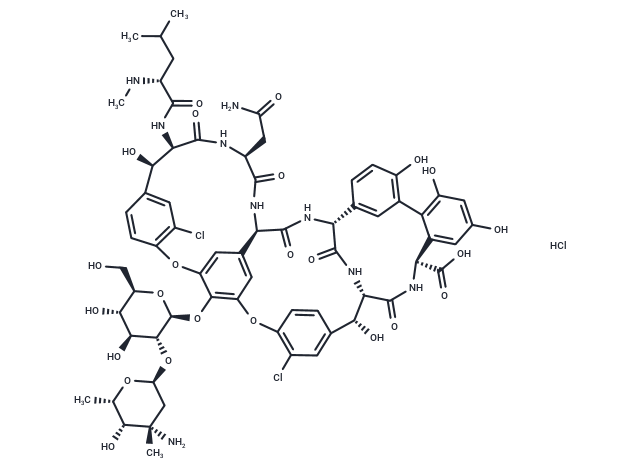Shopping Cart
- Remove All
 Your shopping cart is currently empty
Your shopping cart is currently empty

Vancomycin hydrochloride (Vancomycin HCl) is the hydrochloride salt of vancomycin, a branched tricyclic glycosylated peptide with bactericidal activity against most organisms and bacteriostatic effect on enterococci.

| Pack Size | Price | Availability | Quantity |
|---|---|---|---|
| 1 g | $54 | In Stock |
| Description | Vancomycin hydrochloride (Vancomycin HCl) is the hydrochloride salt of vancomycin, a branched tricyclic glycosylated peptide with bactericidal activity against most organisms and bacteriostatic effect on enterococci. |
| In vitro | Vancomycin, a substantial glycopeptide antibiotic with a molecular weight of 1450 Da[1], stands out due to its unique structure and mode of action, distinguishing it from all currently available antibiotics. Its distinctive mechanism targets and inhibits the second stage of cell wall synthesis in susceptible bacteria. Active against an extensive array of Gram-positive species including Staphylococcus aureus, Staph. epidermidis, Str. agalactiae, Str. bovis, Str. mutans, viridans streptococci, and enterococci[2], vancomycin is a critical asset in treating various bacterial infections. |
| In vivo | Vancomycin is administered via intravenous infusion over a minimum of one hour to reduce the risk of infusion-related adverse effects. In individuals with normal creatinine clearance levels, the distribution phase (α) of vancomycin spans between 30 minutes to 1 hour, while the elimination half-life (β) ranges from 6 to 12 hours. Its distribution volume lies between 0.4–1 L/kg, and its protein-binding capacity varies between 10% and 50%. The efficacy of vancomycin is influenced by factors such as tissue distribution, inoculum size, and protein-binding impacts. Furthermore, vancomycin therapy in infected mice demonstrates significant improvements in clinical outcomes, diarrhea, histopathological scores, and survival rates during the course of treatment. |
| Alias | Vancomycin HCl |
| Molecular Weight | 1485.71 |
| Formula | C66H76Cl3N9O24 |
| Cas No. | 1404-93-9 |
| Smiles | C[C@H]1[C@H]([C@@](C[C@@H](O1)O[C@@H]2[C@H]([C@@H]([C@H](O[C@H]2OC3=C4C=C5C=C3OC6=C(C=C(C=C6)[C@H]([C@H](C(=O)N[C@H](C(=O)N[C@H]5C(=O)N[C@@H]7C8=CC(=C(C=C8)O)C9=C(C=C(C=C9[C@H](NC(=O)[C@H]([C@@H](C1=CC(=C(O4)C=C1)Cl)O)NC7=O)C(=O)O)O)O)CC(=O)N)NC(=O)[C@@H](CC(C)C)NC)O)Cl)CO)O)O)(C)N)O.Cl |
| Relative Density. | 1.657 g/cm3 |
| Storage | Powder: -20°C for 3 years | In solvent: -80°C for 1 year | Shipping with blue ice. | |||||||||||||||||||||||||
| Solubility Information | H2O: 33.33 mg/mL (22.43 mM), Sonication is recommended. DMSO: 55 mg/mL (37.02 mM), Sonication and heating are recommended. | |||||||||||||||||||||||||
Solution Preparation Table | ||||||||||||||||||||||||||
H2O/DMSO
| ||||||||||||||||||||||||||

Copyright © 2015-2025 TargetMol Chemicals Inc. All Rights Reserved.